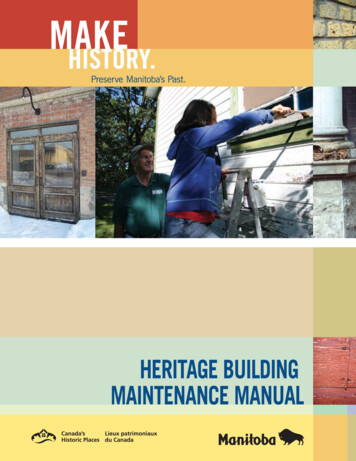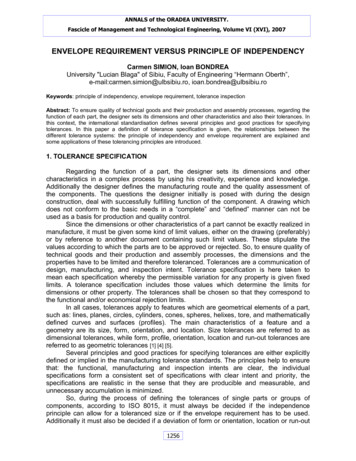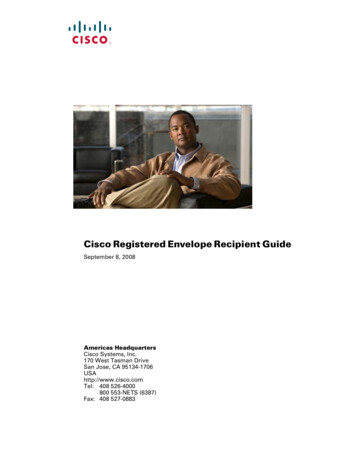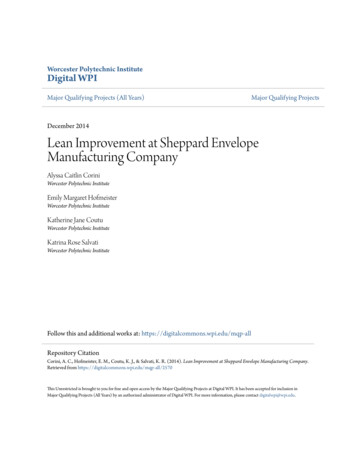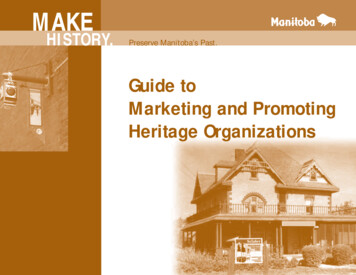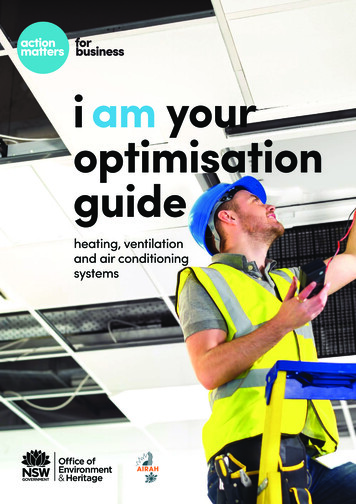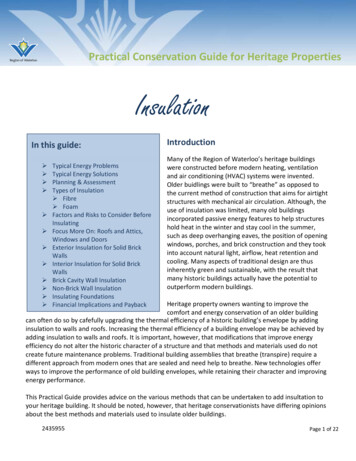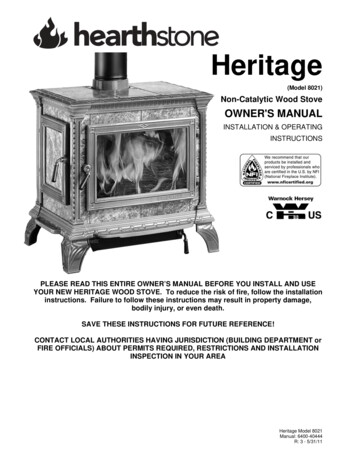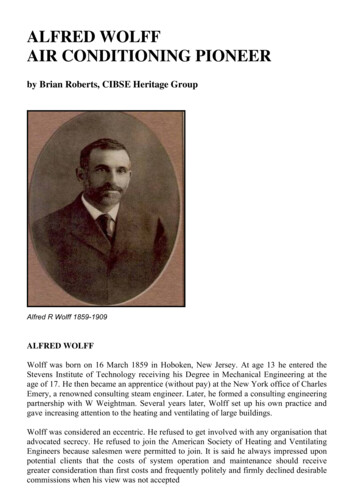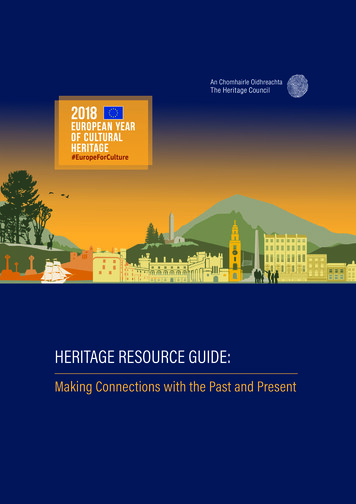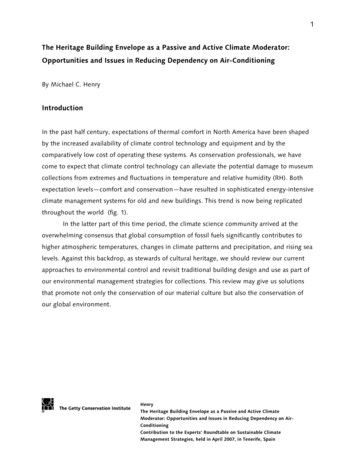
Transcription
1The Heritage Building Envelope as a Passive and Active Climate Moderator:Opportunities and Issues in Reducing Dependency on Air-ConditioningBy Michael C. HenryIntroductionIn the past half century, expectations of thermal comfort in North America have been shapedby the increased availability of climate control technology and equipment and by thecomparatively low cost of operating these systems. As conservation professionals, we havecome to expect that climate control technology can alleviate the potential damage to museumcollections from extremes and fluctuations in temperature and relative humidity (RH). Bothexpectation levels—comfort and conservation—have resulted in sophisticated energy-intensiveclimate management systems for old and new buildings. This trend is now being replicatedthroughout the world (fig. 1).In the latter part of this time period, the climate science community arrived at theoverwhelming consensus that global consumption of fossil fuels significantly contributes tohigher atmospheric temperatures, changes in climate patterns and precipitation, and rising sealevels. Against this backdrop, as stewards of cultural heritage, we should review our currentapproaches to environmental control and revisit traditional building design and use as part ofour environmental management strategies for collections. This review may give us solutionsthat promote not only the conservation of our material culture but also the conservation ofour global environment.HenryThe Heritage Building Envelope as a Passive and Active ClimateModerator: Opportunities and Issues in Reducing Dependency on AirConditioningContribution to the Experts’ Roundtable on Sustainable ClimateManagement Strategies, held in April 2007, in Tenerife, Spain
2This paper considers: the evolving concept of thermal comfort and its definition based on availableenvironmental control technology; the heritage building and its envelope as environmental management system; opportunities to reemploy building features in the management of the interiorenvironment, thereby reducing the need for conventional approaches to airconditioning; potential issues and risks associated with reemploying building features as an overallstrategy of environmental management for heritage buildings; climate change and the necessity to consider alternatives to air-conditioning.Concepts and Definitions of Thermal ComfortHistorian John E. Crowley noted that the present concept of human physical comfort emergesas a value in eighteenth-century material culture:Historical changes in the technology of elementary comforts depended on theexistence of a fashion conscious public that was made aware of the discomfort of whathad been previously considered functionally adequate. The processes by which culturalimperatives shaped new patterns of consumption are particularly evident in the preindustrial context, where changes in the design and use of domestic space and itsfacilities were far more dramatic than can be accounted for by technologicalinnovations alone . . . Concern with comfort provided a rationale for moderate butinnovative patterns of consumption that transcended both the aristocratic imperativesof luxury and the necessities of poverty. (Crowley 2001, 291–92)The engineering definition of human thermal comfort is preceded by the availability oftechnology to address heating, cooling, and air-conditioning processes, thus reinforcingCrowley’s premise that comfort is continuously redefined by technological availability andconsumption, as well as by other factors. The history of the engineering definition of comfortHenryThe Heritage Building Envelope as a Passive and Active ClimateModerator: Opportunities and Issues in Reducing Dependency on AirConditioningContribution to the Experts’ Roundtable on Sustainable ClimateManagement Strategies, held in April 2007, in Tenerife, Spain
3begins in 1918 with the laboratory of the American Society of Heating and VentilatingEngineers (Cooper 1998, 101). The late-twentieth-century engineering definition of occupantthermal comfort evolved as the psychological response to physical heat and moisture balancewith the thermal environment, or “that state of mind which expresses satisfaction with thethermal environment” and is expressed as specific ranges of temperature and RH conditions(ASHRAE 2005, 8.1).However, the engineering definition must be viewed in the context of its necessity inthe design process. An engineer needs a quantitative statement of desired outcomes on whichto base designs for interior environmental control. The design of the system to provide thesedefined comfort conditions is based on identification of a control volume, usually the buildingenvelope, and the heating/cooling, humidification/dehumidification, and ventilation loads onthe control volume. Thus, a consequence of the design process is the emphasis on resultantconditions, enclosure, and control, since certainty in calculations is preferable to ambiguity, andsince a major source of ambiguity in the actual system performance is the potential operabilityof the exterior envelope by building occupants (adaptive behavior). The result of theengineered approach is “the choice of design professionals, engineers and architects, whofavor a controlled and rational system, a building that is so integrated with its mechanicalservices that it has become a machine itself and is controlled by technical authority” (Cooper1998, 3).Although the guidance issued to engineers acknowledges potential adaptive occupantbehavior in maintaining individual comfort, the engineering concept of adaptive behavior isconstrained within the presumption of a controlled interior environment: “In general, thevalue of using an adaptive model to specify set points or guide temperature control strategiesis likely to increase with the freedom that occupants are given to adapt (e.g., by havingflexible working hours, locations, or dress codes)” (ASHRAE 2005, 8.19). The engineeringdefinition of adaptive behavior is restrictive, since others have found that if occupants aregiven the opportunity to exercise some control over their environment, they will tolerate agreater range of variation in environmental conditions than if they have no control, as withcentralized systems (Roaf, Crichton, and Nicol 2005, 117–24).HenryThe Heritage Building Envelope as a Passive and Active ClimateModerator: Opportunities and Issues in Reducing Dependency on AirConditioningContribution to the Experts’ Roundtable on Sustainable ClimateManagement Strategies, held in April 2007, in Tenerife, Spain
4Some argue that, in addition to a constrained definition of adaptive behavior byoccupants, the engineering definition of thermal comfort does not sufficiently account forother factors, such as architectural openness: “openness, the lack of enclosure, is a perceptualcondition that strongly affects expectations and thus provides a measure or prediction ofthermal satisfaction that is a distinctly different set from those accepted in enclosed spaces”(Cook [2001]).The tension between the four-season controlled artificial interior environment and anoccupant-modified adaptive environment begins with the introduction of mass-market airconditioning after World War II. It continues today as architects reexamine the energy costs ofbuilding operations and the potential benefits, economic and environmental, of buildingalternatives to the sealed, climate controlled building.Expectations of Thermal Comfort, Buildings, and Air-ConditioningCrowley’s premise that eighteenth-century expectations of comfort evolved with availabletechnology and consumption may also be applied to the redefinition of thermal comfort as aresult of air-conditioning in buildings in the late twentieth century. In the case of airconditioning, engineers, consumers, and corporations used “a variety of tactics in theseesawing power relations surrounding the development of air-conditioning, includingrhetoric, models, government regulation, guarantees, industry standards, experimentalscience, and quantitative standards” (Cooper 1998, 5).In 1969, when Reyner Banham published his seminal book The Architecture of theWell-Tempered Environment, air-conditioning was an expensive option on American cars, andcentral air-conditioning was available in new postwar housing. Historian Gail Cooper noted,“Largely as a consequence of modern design and construction imperatives, then, airconditioning moved quite rapidly from a luxury to a necessity in the building industry”(Cooper 1998, 157).When the National Building Museum presented the 1999 exhibition Stay Cool! AirConditioning America, 90 percent of newly constructed U.S. homes featured central airconditioning, and two-thirds of existing homes had central air-conditioning, while one-thirdHenryThe Heritage Building Envelope as a Passive and Active ClimateModerator: Opportunities and Issues in Reducing Dependency on AirConditioningContribution to the Experts’ Roundtable on Sustainable ClimateManagement Strategies, held in April 2007, in Tenerife, Spain
5had room or window air conditioners. In the same year, penetration of factory-installed airconditioning in the U.S. automobile and light truck market approached 100 percent.Across the United States, the availability of year-round interior climate control inbuildings and vehicles profoundly changed public and personal expectations of environmentalcomfort and the individual’s relationship with the natural environment. Systems automaticallyintercede in controlling the interior environment, and building design has eliminated many ofthe traditional features for individual control, such as operable windows and shading devices.In the span of one generation, most people in the United States have come to expectthat personal environmental comfort will be maintained continuously by heating and airconditioning systems. As a result, we have become disconnected from the seasonal shifts ofclimate, its nuances, and its daily manifestation as weather. Personal observations of weatherand climate are largely secondhand, reported by media meteorologists or Internet weatherservices, with an emphasis on the catastrophic extremes that strain our mechanical systemsand energy supply infrastructure, upsetting our artificially maintained comfort.Collections Environments and Air-ConditioningThe increased availability of environmental systems, especially air-conditioning for humancomfort and industrial applications, not only influenced the definition of human thermalcomfort but also provided the museum community with the technology to control theenvironment of collection spaces.In the late twentieth century, with the advent of solid-state digital dataloggers formeasuring and recording environmental conditions, environmental monitoring becameincreasingly economical. These devices were quickly embraced by museum professionals. Thedigital data collected could be readily analyzed and presented with personal computersoftware, thus alerting collections stewards to the extremes and variations in temperature andRH in their museum, library, or archives spaces.In some instances, the data presentation and digital display could imply a level ofmeasurement precision that exceeded the performance specifications of the logging device.One outcome was an expectation that the capability to measure interior conditions preciselyHenryThe Heritage Building Envelope as a Passive and Active ClimateModerator: Opportunities and Issues in Reducing Dependency on AirConditioningContribution to the Experts’ Roundtable on Sustainable ClimateManagement Strategies, held in April 2007, in Tenerife, Spain
6implied a capability to control the machinery and systems that maintained the interiorconditions with the same degree of precision. This expectation tended to be codified inenvironmental specifications for collections conservation.Engineers, architects, and mechanical contractors, being problem solvers by trainingand inclination, were responsive to the challenge of close control for collectionsenvironments. However, the resultant systems came at a premium in installation andoperating costs. Furthermore, the complexity and lack of transparency of the control systemsserved to distance museum personnel from the very systems intended to protect thecollections.Eventually, engineering and conservation professions jointly defined targetenvironmental conditions for collections (ASHRAE 2003), somewhat paralleling the evolutionof the engineering definition of thermal comfort conditions. For the most part, concerns withcollections longevity place primacy on reducing variations and extremes in RH rather than oncontrolling temperature.The American Society of Heating, Refrigerating, and Air-Conditioning Engineers(ASHRAE) engineering guidelines (ASHRAE 2003, 21.8, table 4) address the desiredpsychrometric parameters as a function of (1) collections materials, and (2) class ofenvironmental control with respect to RH and temperature set points and variability. Theselection of the class of control is influenced by the building, including factors such asconstruction, typology, use, and systems (ASHRAE 2003, 21.9, table 5).The ASHRAE guidance provides information on appropriate systems, notably those forthe more demanding classes of control, but is silent on how to design or implementapproaches that are based on operation of the building envelope.The Heritage Building as a Passive and Active Climate ModeratorHeritage buildings that predate the development of four-season climate management systemstypically had some inherent capability to moderate external influences on interior conditions.In these older structures, the building itself was the system for ventilation and human comfort.The hygrothermal performance of these buildings relied on building materials, thermal mass,HenryThe Heritage Building Envelope as a Passive and Active ClimateModerator: Opportunities and Issues in Reducing Depende
the heritage building and its envelope as environmental management system; opportunities to reemploy building features in the management of the interior environment, thereby reducing the need for conventional approaches to air- conditioning; potential issues and risks associated with reemploying building features as an overall strategy of environmental management for heritage buildings .
